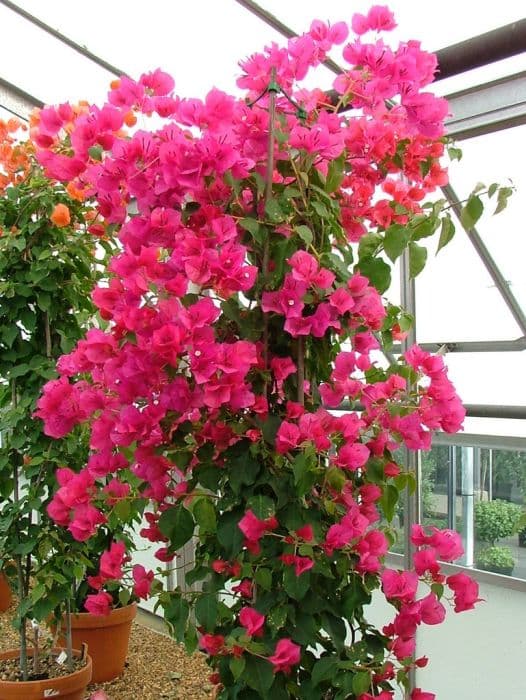Bougainvillea Bougainvillea × buttiana 'Poulton's Special'

ABOUT
Bougainvillea × buttiana 'Poulton's Special' boasts a splendid display of vibrant color. This plant is adorned with large, paper-like structures that might be mistaken for flowers but are actually modified leaves called bracts. These bracts come in a rich shade of magenta-pink, creating a stunning visual impact. The real flowers of the plant are quite small, inconspicuous, and typically white in color, nestled within the bold bracts. The leaves of 'Poulton's Special' are equally attractive, with a leathery texture and deep green hue, providing a lush backdrop for the colorful bracts. The foliage often has a pointed, oval shape, adding to the plant's overall aesthetic with a sharp and clean look. When in full bloom, the contrast of the green leaves against the magenta-pink bracts provides a striking color palette that can add a tropical flair to any setting. This variety of bougainvillea is known for its vigorous and sprawling growth habit, often used for adding a splash of color to garden walls, trellises, or as a ground cover in suitable climates. Its appearance can bring an exotic and vibrant feel to gardens and landscapes where it grows.
About this plant
 Names
NamesFamily
Nyctaginaceae
Synonyms
Paper Flower, Lesser Bougainvillea
Common names
Bougainvillea × buttiana 'Poulton's Special'.
 Toxicity
ToxicityTo humans
Bougainvilleas are not highly toxic to humans, but they can cause minor irritations. If ingested, the Bougainvillea, commonly known, may cause gastrointestinal upset, including nausea, vomiting, or diarrhea. It is also possible to have skin irritation from handling the plant or cuts from its sharp thorns.
To pets
Bougainvilleas are also not highly toxic to pets, but they can cause similar irritations as in humans. If a pet ingests part of a Bougainvillea, they might experience mild vomiting or diarrhea. The plant's thorns may also cause physical injury if a pet comes into contact with them. It's important to discourage pets from chewing on this plant due to the potential for gastrointestinal upset and physical harm from the thorns.
 Characteristics
CharacteristicsLife cycle
Perennials
Foliage type
Evergreen
Color of leaves
Green
Flower color
Varies
Height
10-15 feet (3-4.5 meters)
Spread
6-8 feet (1.8-2.4 meters)
Plant type
Shrub
Hardiness zones
9
Native area
South America
Benefits
 General Benefits
General Benefits- Vivid Color - The Bougainvillea 'Poulton's Special' offers bright and vibrant pink-purple bracts that add significant aesthetic appeal to gardens and landscapes.
- Drought Tolerance - Once established, it is tolerant of drought, making it an excellent choice for drier climates or water-wise gardens.
- Heat Resistance - It thrives in hot conditions, which is ideal for warm climates where other plants might struggle.
- Easy Maintenance - This plant requires minimal care once established, needing only occasional pruning to maintain shape and encourage blooming.
- Versatility - Can be trained as a climbing vine or trimmed into a bushy shrub, allowing for various uses in landscaping and garden design.
- Long Blooming Period - It provides a long-lasting display of color, often from spring to autumn, to brighten up outdoor spaces.
- Wildlife Attraction - Its flowers attract pollinators such as bees and butterflies, promoting biodiversity.
- Fast Growing - The plant grows quickly, which is beneficial for new gardens or when trying to establish coverage or privacy screens in a short amount of time.
- Soil Adaptability - It adapts to most soil types, provided they are well-draining, making it suitable for various garden conditions.
 Medical Properties
Medical PropertiesThis plant is not used for medical purposes.
 Air-purifying Qualities
Air-purifying QualitiesThis plant is not specifically known for air purifying qualities.
 Other Uses
Other Uses- Bougainvillea can be used in bonsai art, where it can be trained and pruned over years to create miniature tree-like sculptures due to its woody stems and vibrant color.
- The vibrant bracts of the bougainvillea can be used as a natural colorant to dye fabrics or papers, providing hues ranging from pinks to reds.
- The thorny stems of the bougainvillea can serve as a natural barrier when planted along borders or fences to discourage trespassers or wildlife from entering a property.
- Bougainvillea branches can be dried and fashioned into decorative wreaths or wall hangings, particularly popular in regions where the plant thrives.
- The plant can be used in landscape design to cover and beautify less attractive structures such as sheds, garages, or walls, due to its rapid and lush growth.
- In certain cultures, bougainvillea flowers and bracts are used in wedding ceremonies and festivities as symbols of beauty and vibrant life.
- Fallen bougainvillea petals can be collected and used in potpourri mixtures, adding color and a light fragrance to the mix.
- The plant's ability to thrive in harsh conditions makes it suitable for urban greening projects aimed at beautifying and revitalizing city environments.
- Bougainvillea can be trained to grow over pergolas or archways, providing shaded areas that are both functional and visually appealing in gardens and parks.
- In photography and painting, the rich and vivid color of bougainvillea can be leveraged as a stunning backdrop or as a contrasting element to emphasize the subject.
Interesting Facts
 Feng Shui
Feng ShuiThe Bougainvillea is not used in Feng Shui practice.
 Zodiac Sign Compitability
Zodiac Sign CompitabilityThe Bougainvillea is not used in astrology practice.
 Plant Symbolism
Plant Symbolism- Passion: Bougainvillea is often associated with passion due to its vibrant and explosive colors, reminiscent of intense emotions and fiery love.
- Beauty: The plant's stunning blooms reflect beauty and are often seen as a representation of attractiveness and splendor.
- Survival: Bougainvillea's ability to thrive in harsh conditions symbolizes persistence and the spirit to survive despite challenges.
- Welcoming: Because of its use in decorating homes and streets, bougainvillea is symbolic of hospitality and a warm welcome.
 Water
WaterBougainvilleas, including the 'Poulton's Special', should be watered when the top inch of soil is dry, which typically means once a week, but this can vary depending on climate and weather conditions. It is important to water deeply, providing enough water so that it reaches the root zone. An established plant may require around one gallon of water each time, ensuring the soil is moist but not soggy. During the growing season, in hotter temperatures, the frequency may increase, and conversely, in cooler temperatures or during the dormant period, watering should be reduced. Always allow the top layer of soil to dry out between watering sessions to prevent root rot.
 Light
LightThe Bougainvillea 'Poulton's Special' thrives best in full sun conditions, receiving more than six hours of direct sunlight daily. An ideal spot for this plant is a south-facing location where it is exposed to ample sunlight throughout the day. In regions with very intense midday sun, some light afternoon shade may be beneficial to prevent leaf scorch.
 Temperature
TemperatureBougainvilleas, such as the 'Poulton's Special', prefer warm environments and perform best when temperatures are between 60°F and 100°F. They can withstand minimal frost but may suffer damage or die back in temperatures below 30°F. The ideal temperature range for bougainvillea growth is from 70°F to 85°F.
 Pruning
PruningPruning Bougainvillea 'Poulton's Special' encourages new growth and more flowers. The best time to prune is after the plant has finished blooming, typically in late winter or early spring. Prune by cutting away any dead wood, overgrown branches, or to shape the plant. Light pruning can be done throughout the year to maintain the desired shape and size.
 Cleaning
CleaningAs needed
 Soil
SoilFor Bougainvillea, a well-draining soil mix is crucial. A combination of two parts potting soil, one part perlite or coarse sand, and one part peat or organic compost works well. Bougainvillea prefers slightly acidic to neutral soil with a pH of 5.5 to 6.5.
 Repotting
RepottingBougainvillea should be repotted every 2-3 years, or when it becomes root-bound. It's best to repot in spring, just before the growing season starts.
 Humidity & Misting
Humidity & MistingBougainvillea thrives best at moderate humidity levels, but it is quite tolerant and can adapt to a range of conditions. Generally, no special humidity adjustments are necessary.
 Suitable locations
Suitable locationsIndoor
Provide full sun, limited water, and strong support.
Outdoor
Plant in full sun, well-draining soil, and provide support.
Hardiness zone
9-11 USDA
 Life cycle
Life cycleBougainvillea × buttiana 'Poulton's Special', commonly known as Bougainvillea, begins its life cycle when a seed germinates in well-drained soil with ample sunlight. The seedling stage comprises of initial leaf development as the plant establishes its root system. After establishing its roots, the Bougainvillea enters the vegetative stage, rapidly growing vines and leaves in favourable conditions. The flowering stage follows, with the plant producing vibrant, papery bracts surrounding small, white flowers during the warmer months, typically repeated in cycles if the plant is well-maintained. As it matures, the Bougainvillea may undergo periods of dormancy, particularly in cooler seasons, reducing growth and flower production. Finally, if left undisturbed, Bougainvillea can live for many years, continuously going through cycles of growth and dormancy, with each cycle contributing to the thickening of woody stems and expansion of its overall size.
 Propogation
PropogationPropogation time
Spring-Summer
The most popular method for propagating Bougainvillea x buttiana 'Poulton's Special', commonly known as Bougainvillea, is through semi-hardwood cuttings. This is typically done in late summer, as the new growth begins to harden. To propagate, a cutting about 4 to 6 inches (10 to 15 centimeters) long is taken from a healthy parent plant. The bottom leaves are removed, and the cut end is dipped in rooting hormone to encourage root development. The cutting is then planted in a well-draining potting mix and kept in a warm, humid environment with indirect light. Over several weeks, the cutting will develop roots and can eventually be transplanted into the garden or a larger pot.


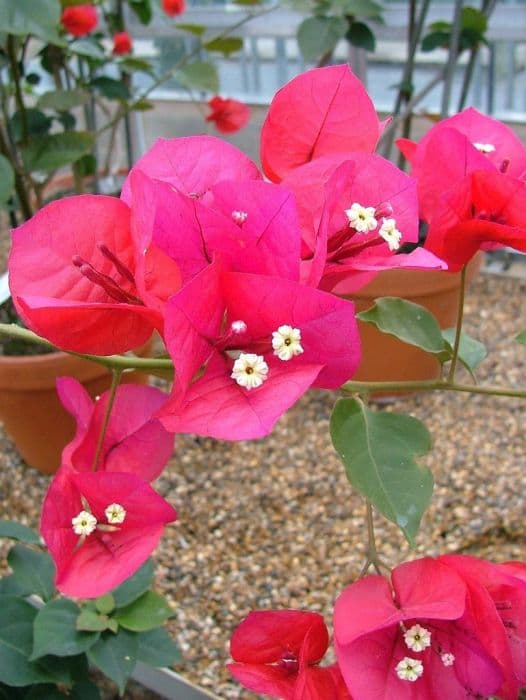

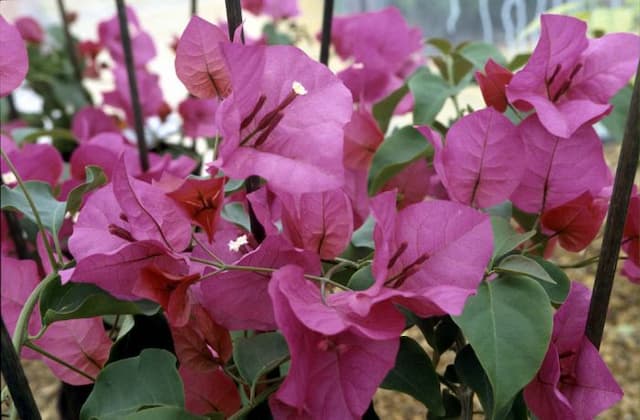
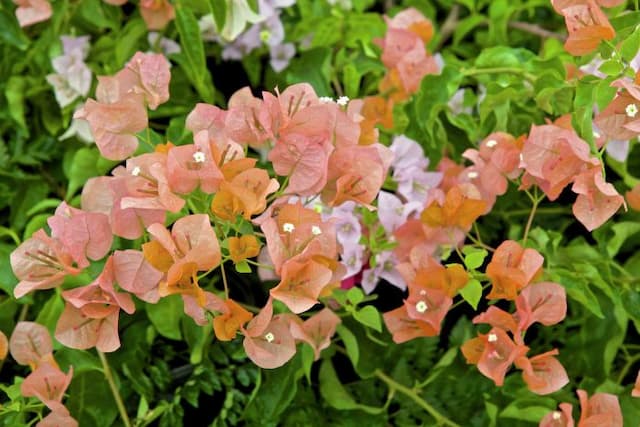
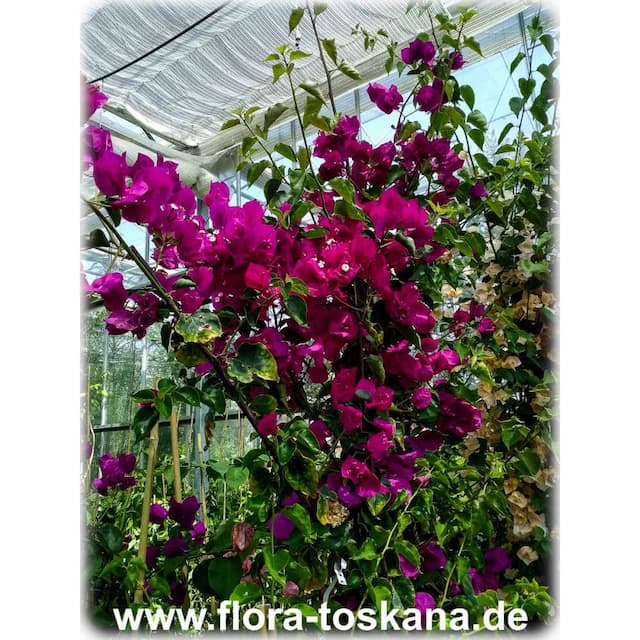
![Bougainvillea [Texas Dawn]](/_next/image?url=https%3A%2F%2Fplants-admin.emdemapps.com%2Fimages%2Fplants%2F%2Fimages%2F604b5f2598081.png&w=640&q=75)
